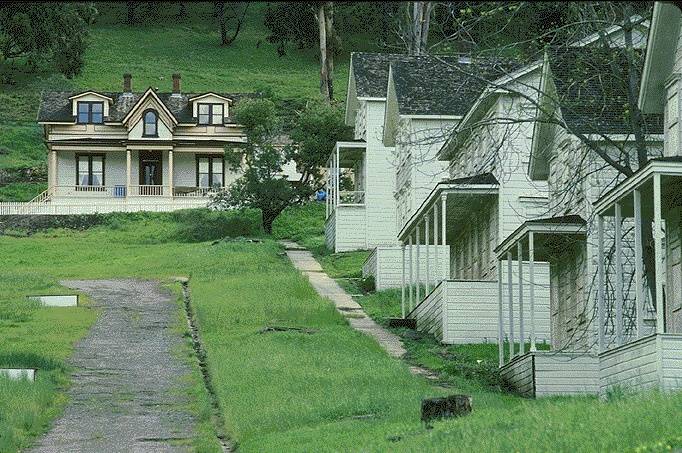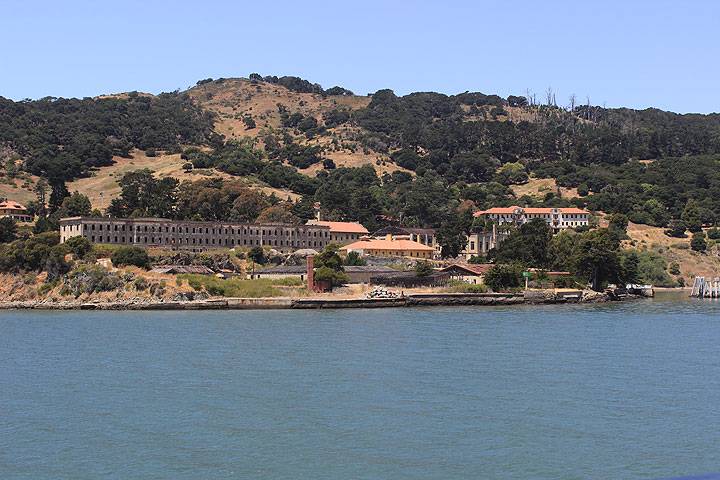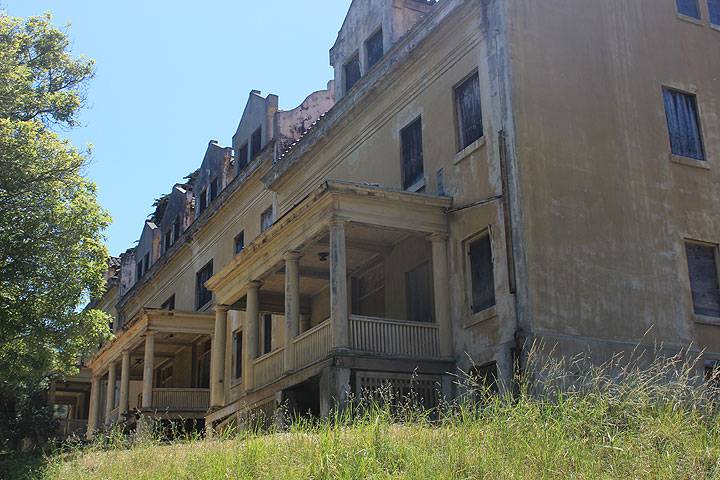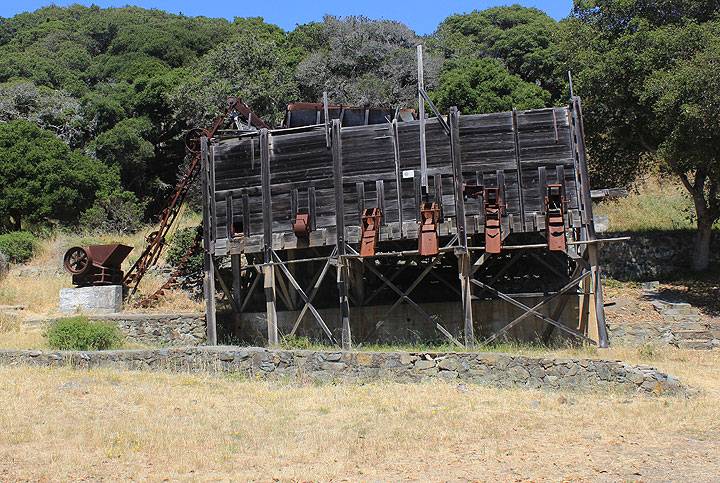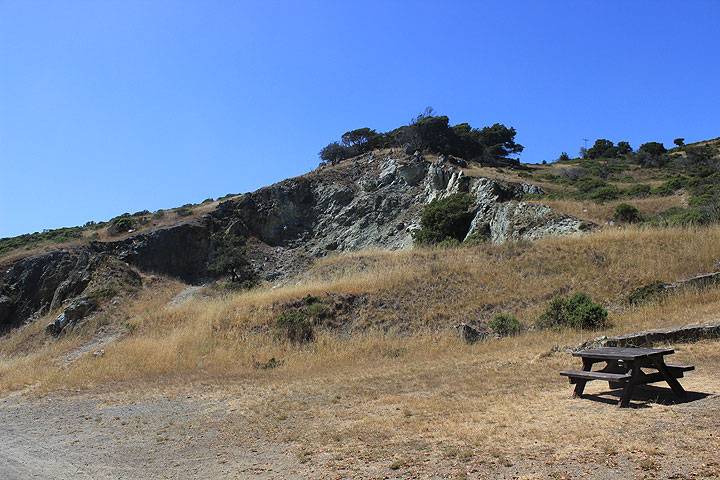The Curious Ruins of Angel Island: Difference between revisions
mNo edit summary |
(added new photos) |
||
| (4 intermediate revisions by 2 users not shown) | |||
| Line 1: | Line 1: | ||
'''<font face = Papyrus> <font color = maroon> <font size = 4>Historical Essay</font></font> </font>''' | |||
''by Dr. Weirde'' | |||
[[Image:outofsf$camp-reynolds.jpg]] | [[Image:outofsf$camp-reynolds.jpg]] | ||
'''Camp Reynolds, a Civil War-era fort, once inhabited by officers and their families.''' | '''Camp Reynolds, a Civil War-era fort, once inhabited by officers and their families.''' | ||
''Photo: Chris Carlsson'' | |||
[[Image:Angel-island-east-side-abandoned-buildings 2451.jpg]] | |||
'''Abandoned military buildings on east side of Angel Island, 2014.''' | |||
''Photo: Chris Carlsson'' | |||
[[Image:Angel-island-abandoned-quarters 2514.jpg]] | |||
'''Abandoned living quarters, east side of Angel Island.''' | |||
''Photo: Chris Carlsson'' | |||
Angel Island's military history goes back far beyond the insanity of the Cold War. During the Civil War, the island housed a fort, which, like the fortifications at the mouth of the Golden Gate, served as an utterly ineffectual defense against an invasion that would never arrive. The military base later became a troop embarkation point during World War Two, housing over a thousand soldiers at a time. | Angel Island's military history goes back far beyond the insanity of the Cold War. During the Civil War, the island housed a fort, which, like the fortifications at the mouth of the Golden Gate, served as an utterly ineffectual defense against an invasion that would never arrive. The military base later became a troop embarkation point during World War Two, housing over a thousand soldiers at a time. | ||
| Line 7: | Line 25: | ||
From 1906 until World War Two, the Island's barracks served as an [[Island of Immortals: Chinese Immigrants and the Angel Island Immigration Station| internment camp]] for mostly Chinese immigrants. You can still see the graffiti they left behind, mixed with the racier (and, for English speakers, more comprehensible) commentaries etched in stone by soldiers en route to their likely deaths in the bloody war in the Pacific. | From 1906 until World War Two, the Island's barracks served as an [[Island of Immortals: Chinese Immigrants and the Angel Island Immigration Station| internment camp]] for mostly Chinese immigrants. You can still see the graffiti they left behind, mixed with the racier (and, for English speakers, more comprehensible) commentaries etched in stone by soldiers en route to their likely deaths in the bloody war in the Pacific. | ||
--'' | [[Image:Angel-island-quarry-equipment 2572.jpg]] | ||
'''Abandoned quarry equipment, southwest slope of Angel Island, 2014.''' | |||
''Photo: Chris Carlsson'' | |||
[[ | [[Image:Angel-island-quarry 2573.jpg]] | ||
'''Long abandoned quarry, Angel Island.''' | |||
'' | ''Photo: Chris Carlsson'' | ||
[[Island of Immortals: Chinese Immigrants and the Angel Island Immigration Station |More Angel Island]] | |||
[[Island of Evil Spirits |Prev. Document]] [[Island of Immortals: Chinese Immigrants and the Angel Island Immigration Station |Next Document]] | |||
[[ | [[category:San Francisco outside the city]] [[category:1860s]] [[category:military]] [[category:1900s]] [[category:1940s]] [[category:2010s]] | ||
Latest revision as of 21:21, 5 August 2014
Historical Essay
by Dr. Weirde
Camp Reynolds, a Civil War-era fort, once inhabited by officers and their families.
Photo: Chris Carlsson
Abandoned military buildings on east side of Angel Island, 2014.
Photo: Chris Carlsson
Abandoned living quarters, east side of Angel Island.
Photo: Chris Carlsson
Angel Island's military history goes back far beyond the insanity of the Cold War. During the Civil War, the island housed a fort, which, like the fortifications at the mouth of the Golden Gate, served as an utterly ineffectual defense against an invasion that would never arrive. The military base later became a troop embarkation point during World War Two, housing over a thousand soldiers at a time.
From 1906 until World War Two, the Island's barracks served as an internment camp for mostly Chinese immigrants. You can still see the graffiti they left behind, mixed with the racier (and, for English speakers, more comprehensible) commentaries etched in stone by soldiers en route to their likely deaths in the bloody war in the Pacific.
Abandoned quarry equipment, southwest slope of Angel Island, 2014.
Photo: Chris Carlsson
Long abandoned quarry, Angel Island.
Photo: Chris Carlsson

